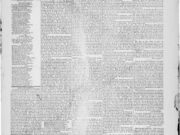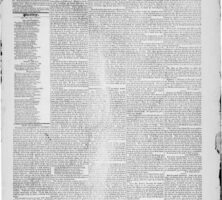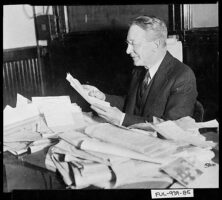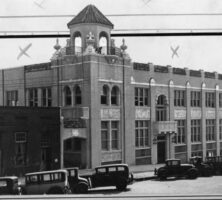The Columbus Ledger-Enquirer is the fourth-oldest newspaper in the state, behind the Augusta Chronicle, the Milledgeville Union-Recorder, and the Macon Telegraph, and has covered news for the people of Columbus, southwest Georgia, and east Alabama since 1828. The paper, which is owned by the McClatchy Company, has won two Pulitzer Prizes for public service and has a daily circulation of more than 25,000, making it one of the largest newspapers in Georgia.
The Columbus Enquirer and the Columbus Ledger
Mirabeau B. Lamar established the Columbus Enquirer as a four-page weekly newspaper in 1828, the same year the General Assembly incorporated the city of Columbus. The paper was politically aligned with the Jeffersonian Democrats and states’ rights advocates. After two unsuccessful runs for Congress and the death of his wife and brother, Lamar sold the paper in 1835 and moved to Texas. He later fought in the Texas Revolution and was eventually elected the first vice president and the second president of the Republic of Texas.
The Enquirer experienced several changes in ownership in the decades that followed. In the 1840s, the paper was aligned with the Whig Party and supported its national candidates. After the collapse of the party, the editors avoided aligning with another political organization but maintained strong support for compromise with the North during the antebellum period. In 1858 the Columbus Enquirer began daily circulation for the first time to maintain readers in response to competition from the newly established Daily Sun. When Georgia seceded from the Union in 1861, the Enquirer supported the decision, thus falling in line with most of the other large newspapers in the state. The Columbus Enquirer managed to survive shortages inflicted by the Civil War (1861-65) and absorbed the Daily Sun in 1874 to become the Enquirer-Sun.
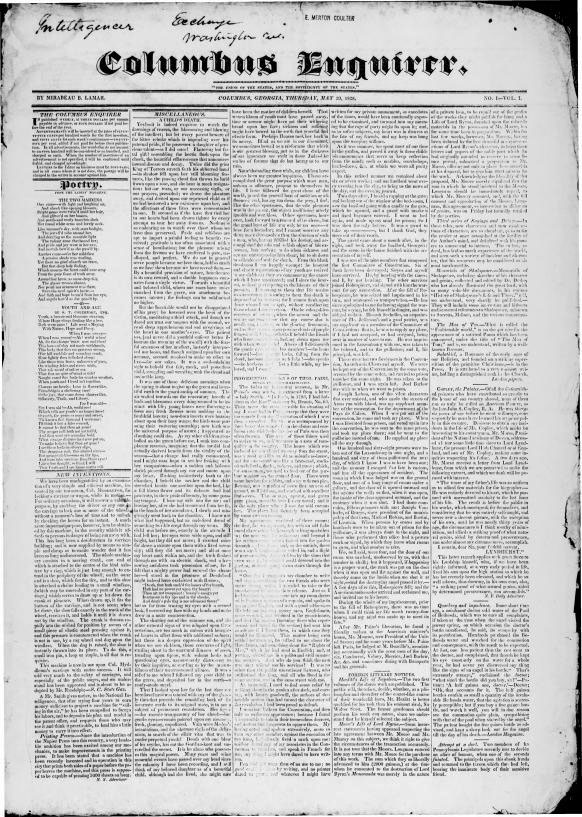
Courtesy of Digital Library of Georgia.
Publisher E. T. Byington and his wife, Elia Goode Byington, established the Columbus Ledger as a new challenger to the Enquirer in 1886. Unlike its competitor, the Ledger was released as an afternoon paper and almost exclusively hired women in its office. Alabama native Rinaldo William Page purchased the Ledger in 1892. Page successfully published the paper through the late nineteenth and early twentieth centuries, during which time it was a strong advocate for Democratic Party policies. The Ledger would remain under Page family ownership for more than eighty years.

Courtesy of Georgia Archives.
Harris Ownership and Consolidation
In 1920 Julian LaRose Harris (son of celebrated writer Joel Chandler Harris) purchased the Columbus Enquirer-Sun with his wife, Julia Collier Harris, and partner Thomas W. Loyless. Under their control, the newspaper became a courageous voice for social advancement and racial justice. The Harrises personally traveled to Tennessee in 1925 to cover the Scopes “monkey” Trial and wrote critically of those who refused to teach evolution in schools. They also investigated the activities of the Ku Klux Klan and bravely editorialized against the group’s views and tactics. Moreover, the Enquirer-Sun opposed lynching practices in Georgia and supported increased educational opportunity for African Americans. The work of Julian and Julia Harris earned the paper the Pulitzer Prize for public service in 1926. It was the second southern newspaper to win the award.
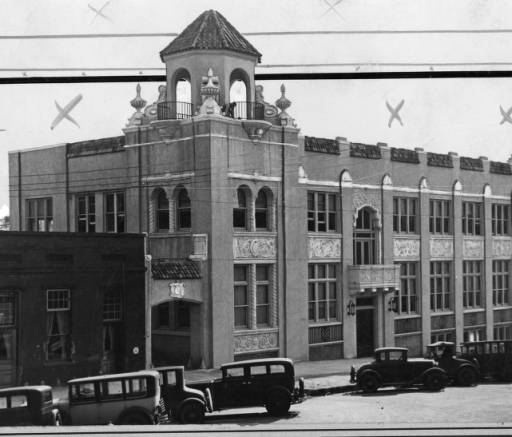
Courtesy of Atlanta Journal-Constitution.
Despite the national recognition, the Harrises were constant victims of threats and vandalism and faced increasing debt that forced them to sell the Enquirer-Sun in 1929. The R. W. Page Corporation, publisher of the Columbus Ledger, purchased the paper the following year. Despite being under sole ownership, the two publications continued individual circulation, with the Enquirer serving as the city’s morning edition and the Ledger as the afternoon edition. The two titles published a combined Sunday Ledger-Enquirer on the weekends.
Modern Day
The papers continued their commitment to quality reporting in the years that followed. In 1955 the Columbus Ledger and Sunday Ledger-Enquirer won its second Pulitzer Prize for public service for its coverage of municipal corruption and organized crime in nearby Phenix City, Alabama. It is the only Georgia newspaper to win that particular award twice. Newspaper publisher Knight Newspapers purchased the papers in 1973 and merged with Ridder Publications the following year to form Knight Ridder. Under their ownership, the Ledger and Enquirer would finally merge into a single daily edition in 1988, forming the Columbus Ledger-Enquirer. In 2006 the McClatchy Company purchased Knight Ridder and its holdings, including the Ledger-Enquirer. The publication continues to deliver news to the citizens of Columbus and the greater southwest Georgia and east Alabama area.


